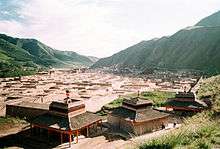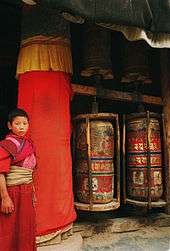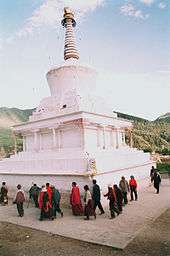Labrang Monastery
| Labrang Monastery | |
|---|---|
 | |
| Tibetan transcription(s) | |
| Tibetan | བླ་བྲང་བཀྲ་ཤིས་འཁྱིལ་ |
| Wylie transliteration | bla brang bkra shis 'khyil |
| THL | Labrang Trashi Khyil |
 Labrang Monastery Location within China | |
| Coordinates | 35°11′44″N 102°30′29″E / 35.19556°N 102.50806°E |
| Monastery information | |
| Location | Gansu Province, Country of Tibet |
| Founded by | Ngawang Tsondru |
| Founded | 1709 |
| Type | Tibetan Buddhist |
| Sect | Gelug |
| Lineage | Jamyang Shêpa |
| Festivals |
January 4–17 June 26 – July 15 |
| Part of a series on |
| Tibetan Buddhism |
|---|
 |
|
Practices and attainment |
|
History and overview |
|
Labrang Monastery (Tibetan: བླ་བྲང་བཀྲ་ཤིས་འཁྱིལ་, Wylie: bla-brang bkra-shis-'khyil ) is one of the six great monasteries of the Gelug school of Tibetan Buddhism. Its formal name is Genden Shédrup Dargyé Trashi Gyésu khyilwé Ling (Tibetan: དགེ་ལྡན་བཤད་སྒྲུབ་དར་རྒྱས་བཀྲ་ཤིས་གྱས་སུ་འཁྱིལ་བའི་གླིང༌།, Wylie: dge ldan bshad sgrub dar rgyas bkra shis gyas su 'khyil ba'i gling ).[1]
Labrang is located in Xiahe County, Gannan Tibetan Autonomous Prefecture, Gansu, in the traditional Tibetan area of Amdo. Labrang Monastery is home to the largest number of monks outside of the Tibet Autonomous Region. Xiahe is about four hours by car from the provincial capital Lanzhou.
In the early part of the 20th century, Labrang was by far the largest and most influential monastery in Amdo. It is located on the Daxia River, a tributary of the Yellow River.[2]
History
The monastery was founded in 1709 by the first Jamyang Shêpa, Ngawang Tsondru.[3][4] It is Tibetan Buddhism's most important monastery town outside the Tibetan Autonomous Region.
Labrang Monastery is situated at the strategic intersection of two major Asian cultures—Tibetan and Mongolian — and was one of the largest Buddhist monastic universities. In the early 20th century, it housed several thousand monks. Labrang was also a gathering point for numerous annual religious festivals and was the seat of a Tibetan power base that strove to maintain regional autonomy through the shifting alliances and bloody conflicts that took place between 1700 and 1950.[5][6]
In April 1985 the Assembly Hall burned down. It was replaced and the new building was consecrated in 1990.[7]
Description
The monastery complex dominates the northern part of the village. The white walls and gilded roofs feature a blend of Tibetan and Indian Vihara architectural styles. The monastery contains 18 halls, six institutes of learning, a gilded stupa, a sutra debate area, and houses nearly 60,000 sutras.
At its height the monastery housed 4,000 monks. Like so many religious institutions, it suffered during the Cultural Revolution; and the monks were sent to their villages to work. After it was reopened in 1980, many of the monks returned; but the government restricted enrolment to around 1,500.[8]
It has a Buddhist museum with a large collection of Buddha statues, sutras and murals. In addition, a large amount of Tibetan language books, including books on history is available for purchase, together with medicines, calendars, music and art objects.
There used to be a great gold-painted statue of the Buddha, more than 50 feet high, which was surrounded by rows of surrounding Buddhas in niches.[9]
The monastery today is an important place for Buddhist ceremonies and activities. From January 4 to 17 and June 26, to July 15, (these dates may change according to the lunar calendar), the great Buddhist ceremony will be held with Buddha-unfolding, sutra enchanting, praying, sutra debates, etc.
Muslim Ma clique attacks


The Chinese Muslim Ma clique under Generals Ma Qi and Ma Bufang launched several attacks against Labrang as part of a general anti-Golok Tibetan campaign.
Ma Qi occupied Labrang Monastery in 1917, the first time non-Tibetans had seized it.[10] Ma Qi defeated the Tibetan forces with his Hui troops.[11] His forces were praised by foreigners who traveled through Qinghai for their fighting abilities.[12]
After ethnic rioting between Hui and Tibetans emerged in 1918, Ma Qi defeated the Tibetans. He heavily taxed the town for 8 years. In 1921, Ma Qi and his Muslim army decisively crushed the Tibetan monks of Labrang Monastery when they tried to oppose him.[13] In 1925, a Tibetan rebellion broke out, with thousands of Tibetans driving out the Hui. Ma Qi responded with 3000 Hui troops, who retook Labrang and machine-gunned thousands of Tibetan monks as they tried to flee.[14] During a 1919 attack by Muslim forces, monks were executed by burning. Bodies were left strewn around Labrang by Hui troops.[15]
Ma Qi besieged Labrang numerous times. Tibetans fought against his Hui forces for control of Labrang until Ma Qi gave it up in 1927.[16] However, that was not the last Labrang saw of General Ma. Ma Qi launched a genocidal war against the Goloks in 1928, inflicting a defeat upon them and seizing Labrang Monastery. The Hui forces looted and ravaged the monastery again.[16]
The Austrian American explorer Joseph Rock encountered the aftermath of one of the Ma clique's campaigns against Labrang. The Ma army left Tibetan skeletons scattered over a wide area and Labrang Monastery was decorated with decapitated Tibetan heads.[17] After the 1929 battle of Xiahe near Labrang, decapitated Tibetan heads were used as ornaments by Hui troops in their camp, 154 in total. Rock described "young girls and children"'s heads staked around the military encampment. Ten to fifteen heads were fastened to the saddle of every Muslim cavalryman.[18] The heads were "strung about the walls of the Moslem garrison like a garland of flowers."[19]
Recent events
In March 2008 there were protests by monks from Labrang Monastery as well as by other ethnic Tibetans linked to previous protests and rioting that broke out in Lhasa.[20]
Footnotes
- ↑ Nietupski (1999), p. 21.
- ↑ Nietupski (1999), p. 16.
- ↑ Berzin, Alexander (2003). "A Brief History of Labrang Monastery. Original version published in "Gelug Monasteries." Chö-Yang, Year of Tibet Edition (Dharamsala, India), (1991)". Study Buddhism. Retrieved 2016-06-06.
- ↑ Chhosphel, Samten (January 2011). "The First Jamyang Zhepa, Jamyang Zhepai Dorje". The Treasury of Lives: Biographies of Himalayan Religious Masters. Retrieved 2013-10-08.
- ↑ LABRANG: A Tibetan Buddhist Monastery at the Crossroads of Four Civilizations
- ↑ LABRANG: A Tibetan Buddhist Monastery at the Crossroads of Four Civilizations (Book Preview Available)
- ↑ Dorje (2009), p. 800.
- ↑ Hill, Julie, (2006), The Silk Road Revisited: Markets, Merchants and Minarets AuthorHouse, Kindle Edition. Kindle Locations 661-662
- ↑ Cabot (2003), p. 153, with photo taken in 1923.
- ↑ Charlene E. Makley (2007). The violence of liberation: gender and Tibetan Buddhist revival in post-Mao China. University of California Press. p. 73. ISBN 0-520-25059-1. Retrieved 2010-06-28.
- ↑ University of Cambridge. Mongolia & Inner Asia Studies Unit (2002). Inner Asia, Volume 4, Issues 1–2. The White Horse Press for the Mongolia and Inner Asia Studies Unit at the University of Cambridge. p. 204. Retrieved 2010-06-28.
- ↑ Frederick Roelker Wulsin, Mary Ellen Alonso, Joseph Fletcher, Peabody Museum of Archaeology and Ethnology, National Geographic Society (U.S.), Peabody Museum of Salem, Pacific Asia Museum (1979). China's inner Asian frontier: photographs of the Wulsin expedition to northwest China in 1923 : from the archives of the Peabody Museum, Harvard University, and the National Geographic Society. The Museum : distributed by Harvard University Press. p. 43. ISBN 0-674-11968-1. Retrieved 2010-06-28.
- ↑ Wulsin, Frederick Roelker; Fletcher, Joseph; Peabody Museum of Archaeology and Ethnology, National Geographic Society (U.S.), Peabody Museum of Salem (1979). Alonso, Mary Ellen, ed. China's inner Asian frontier: photographs of the Wulsin expedition to northwest China in 1923 : from the archives of the Peabody Museum, Harvard University, and the National Geographic Society. Contributor Pacific Asia Museum (illustrated ed.). The Museum : distributed by Harvard University Press. p. 43. ISBN 0674119681. Retrieved 24 April 2014. Cite uses deprecated parameter
|coauthors=(help); horizontal tab character in|others=at position 12 (help) - ↑ James Tyson; Ann Tyson (1995). Chinese awakenings: life stories from the unofficial China. Westview Press. p. 123. ISBN 0-8133-2473-4. Retrieved 2010-06-28.
- ↑ Paul Hattaway (2004). Peoples of the Buddhist world: a Christian prayer diary. William Carey Library. p. 4. ISBN 0-87808-361-8. Retrieved 2011-05-29.
- 1 2 Paul Kocot Nietupski (1999). Labrang: a Tibetan Buddhist monastery at the crossroads of four civilizations. Snow Lion Publications. p. 90. ISBN 1-55939-090-5. Retrieved 2010-06-28.
- ↑ Dean King (2010). Unbound: A True Story of War, Love, and Survival (illustrated ed.). Hachette Digital, Inc. ISBN 0-316-16708-8. Retrieved 2010-06-28.
- ↑ Paul Hattaway (2004). Peoples of the Buddhist world: a Christian prayer diary. William Carey Library. p. 4. ISBN 0-87808-361-8. Retrieved 2011-05-29.
- ↑ Gary Geddes (2008). Kingdom of Ten Thousand Things: An Impossible Journey from Kabul to Chiapas (illustrated ed.). Sterling Publishing Company, Inc. p. 175. ISBN 1-4027-5344-6. Retrieved 2011-05-29.
- ↑ "Open revolt defies China's iron fist". The Sydney Morning Herald. March 17, 2008. Retrieved 2008-06-29.
References
- Cabot, Mabel H. (2003). Vanished Kingdoms: A Woman Explorer in Tibet, China & Mongolia, 1921–1925, pp. 148–157. Aperture Publishers in association with the Peabody Museum, Harvard. ISBN 978-1-931788-18-2.
- Dorje, Gyurme (2009). Footprint Tibet Handbook. Footprint Publications, Bath, England. ISBN 978-1-906098-32-2.
- Nietupski, Paul Kocot (1999), Labrang: A Tibetan Monastery at the Crossroads of Four Civilizations. Snow Lion Publications, Ithica, New York. ISBN 1-55939-090-5.
Further reading
- Makley, Charlene E. (1999). "Gendered Practices and the Inner Sanctum: The Reconstruction of Tibetan Sacred Space in "China's Tibet"." In: Sacred Spaces and Powerful Places in Tibetan Culture: A Collection of Essays, pp. 343–366. Edited by Toni Huber. Library of Tibetan Works and Archives, Dharamsala, H.P., India. ISBN 81-86470-22-0.
- Tamm, Eric Enno. (2010) "The Horse That Leaps Through Clouds: A Tale of Espionage, the Silk Road and the Rise of Modern China," chapter 13. Vancouver: Douglas & McIntyre. ISBN 978-1-55365-269-4.
- Thubron, Colin (2007) Shadow of the Silk Road 58–67 (New York: HarperCollins).
External links
| Wikimedia Commons has media related to Labrang Monastery. |
- Maps and photographic slide shows of Labrang by author Eric Enno Tamm
- A History of Labrang Monastery – At Study Buddhism
- "Labrang Monastery". The Tibetan and Himalayan Library. Retrieved 2013-10-29.
- Monlan Festival – Pictures gallery and information from Monlan festival and Labrang Monastery
- Uprising Archive: Labrang – Pictures of protests in and around Labrang Monastery, March 2008
- Life on the Tibetan Plateau Labrang Monastery
- China Clamps Down on Unrest
Coordinates: 35°11′44″N 102°30′29″E / 35.19556°N 102.50806°E